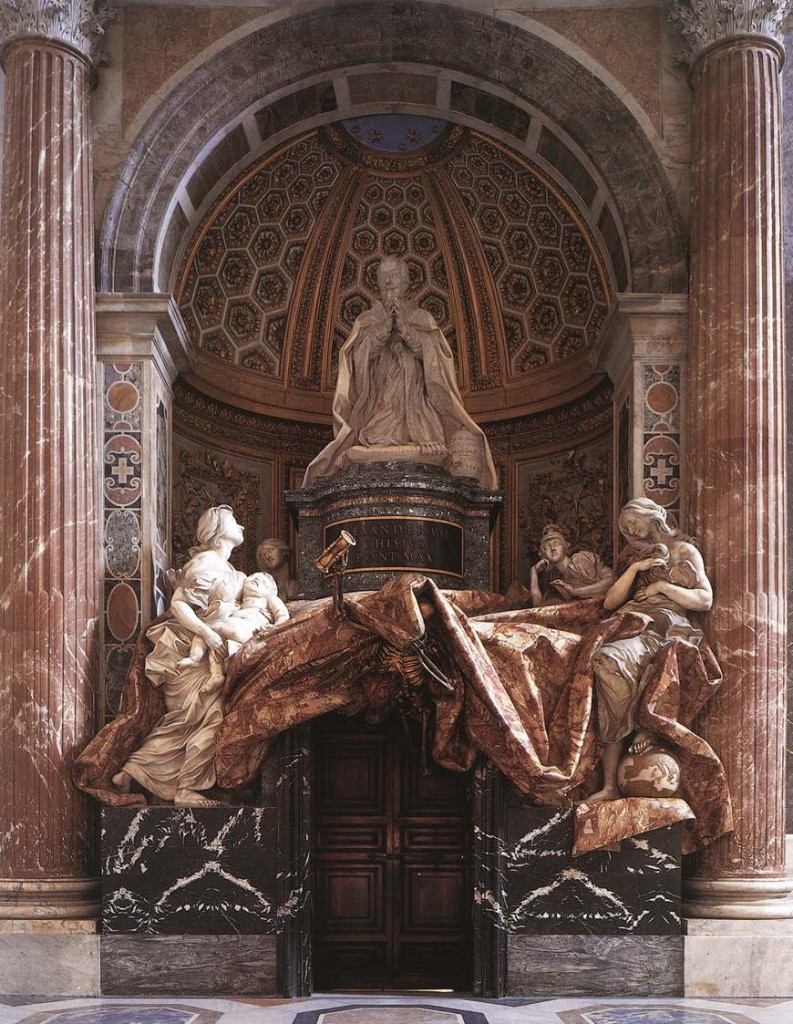Bernini. Counter Reformation overstatement…A pitiless unromantic view of death was another Counter Reformation theme. Bernini went to the macabre iconography of the Middle Ages and borrowed the death’s head for his tombs. The skeletons holding an hourglass in the tomb of Alexander VII and a scroll in the tomb of Urban VIII proclaim that even such illustrious men cannot triumph over time, and that their judgement is yet to come.
The odd thing is that it was in this restrictive period of church history that Bernini pioneered a sculptural and architectural style much freer than that of the Renaissance. He would have been furious at being called baroque. The word, used originally to designate irregularly shaped pearls, first came to mean any work of art that startled through an extravagant and suspect originality, and later signified a specific art style.

— Bernini_David_1623-24
Bernini David 1623-24. It was Cardinal Scipione Borghese who commissioned the statue of David, confronting the giant Goliath and armed only with a sling, executed between 1623 and 1624 by twenty – five – year – old Gian Lorenzo Bernini. The youth ‘s tense facial expression is modelled on Bernini himself as he struggle with his tools to work the hard marble. The oversize cuirass leant to David by King Saul before the encounter lies on the ground with the harp David will play after his victory, which is decorated with an eagle ‘s head, a symbolic reference to the Borghese family.
The number of points of view the sculptor intended to present to the spectator is still a matter of conjecture. The right side shows David ‘s movements, his stride is almost a leap as he aims his sling; seen from the front the pose is frozen, just one second before the fatal shot, and seen diagonally there is a rhytmic balance between movement and pose—Read More:http://www.shafe.co.uk/art/bernini-_david-_rome-_villa_borghese.asp
But Bernini thought of himself as classical. The authority of the ancients, he said, was unchallengeable. He copied Greek sculpture and was inspired by its themes. He explained that “sometimes, to imitate nature, we must do what is not in nature.” It was in this manner that he was able to rationalize distortion as an element of classical style.
Distortion was also a plastic expression of the Counter Reformation mystique: Bernini’s subjects are frozen in some moment of action, as though reminding the faithful that the church was engaged in a mortal struggle against dangerous adversaries. Michelangelo’s David is an ideal figure, outside time, placid, in repose, a monument of latent strength. Bernini’s David is seen at the precise moment when he is firing his sling at Goliath. His mucles are strained, his nostrils flare, his eyes glare under furrowed brows, his mouth is set in determination.

—The other masterpiece Bernini made in the period is the “Rape of Persephone”, also called “Pluto and Proserpina”. The word rape is a strong word- to Bernini in this work, it meant “abduction”. What we see is Pluto(also called Hades), the powerful god of the underworld, kidnapping Persephone and carrying her away. In true Bernini fashion, the act is captured at a moment of intense motion and struggle.She twists her body to free herself, resisting Pluto by pushing against his forehead with her hand. Her other arm is outstretched for help. It’s hard to see her face, but she screams in agony as visible tears, carved into the marble, slide from her eyes and down her cheeks. An elaborate drapery flows in the wind and captures the movement of the struggle as Pluto reaches across his body and grabs onto her thigh. Bernini envisioned the sculpture as an unfolding event, one that could be read from 3 sides.—Read More:http://maitaly.wordpress.com/2011/03/02/bernini-galleria-borghese-the-rape-of-persephone/
In nearly all Bernini’s large works, and even in some of the busts, energy is being expended. In its broadest sense, his baroque style is the artistic expression of a restless, anxious society caught between two eras of humanism, having left the Renaissance and not yet reached the Enlightenment.
Because his sculpture is narrative, Bernini experiments with technique for conveying movement and emotion in stone. He sought sculptural alternatives for the painter’s use of shadow and color. In his depiction of the martyrdom of Saint lawrence marble flames lick up toward the saint. To get a lifelike expression, it has been said, Bernini went so far as to scorch his leg with a brazier and sketched the reflection of his own grimaces in a mirror. In Pluto and Prosperpina the god is carrying off the terrified maiden, whose flesh yields beneath his grasp. To show grief, Bernini sculptured its visible expression: a marble tear.






 COMMENTS
COMMENTS